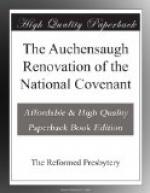The two most noteworthy instances of avowed covenant-renovation within the present century are those at Dervock, Ireland, in 1853, and in Pittsburg, Pennsylvania, in 1871; and we class them together, because however the respective documents differ in their provisions, and in our judgment some of these are irreconcilable, yet the parties have ever since agreed to coalesce. Reference is here made only to a sample of essential discrepancies. In the Dervock bond the British Covenants are expressly mentioned and owned; in the Pittsburg bond they are neither owned nor mentioned, although both were urged at the time, while they were openly vilified without rebuke. In the former Prelacy is abjured, in the latter it is not so much as named. The fourth article of the former is irreconcilable with the fourth article of the latter. The former is limited by recognized truth; the latter substitutes for truth supposed piety. But since these two parties, in the face of such antagonistic fundamental principles, do actually harmonize in practice, coming down to treat with opposing parties in the plain of Ono, their example of treachery in covenant can be regarded only as a beacon of warning.
Strictly speaking, no new obligation has been imposed or assumed since the law was given at Sinai. We are to “keep the words of the covenant, the ten commandments.” This is just what Christ still enjoins upon his disciples—“Teaching them to observe all things whatsoever I have commanded you.” The footsteps of Christ’s flock differ nothing now from what they were in the days of Solomon. Some turn back into Egypt, while others turn aside with the “flocks of the companions to right-hand extremes or left-hand defections”; for the harlot’s “ways are moveable that thou canst not know them,” and we are warned—“Come not near the door of her house.”
The federal deeds which we propose to renew are, of course, those of our witnessing fathers, the National Covenant of Scotland and the Solemn League of Scotland, England and Ireland, adapting these public deeds to our time, and comprising all preceding and subsequent attainments, as was done by our predecessors at Auchensaugh. Our condition and surroundings are in many respects similar to theirs. “Their soul was exceedingly filled with the scorning of those that were at ease, and with the contempt of the proud”; but they were also exposed to many perils from the existing ecclesiastical and civil authorities which they publicly disowned.
All inspired records of public vows to God by his united people, from the time of Moses to Nehemiah, contained a synopsis of special providence towards themselves and others, of sins, mercies and judgments; and these were motives to this special duty, though not a rule—“And because of all this we make a sure covenant and write it.”




